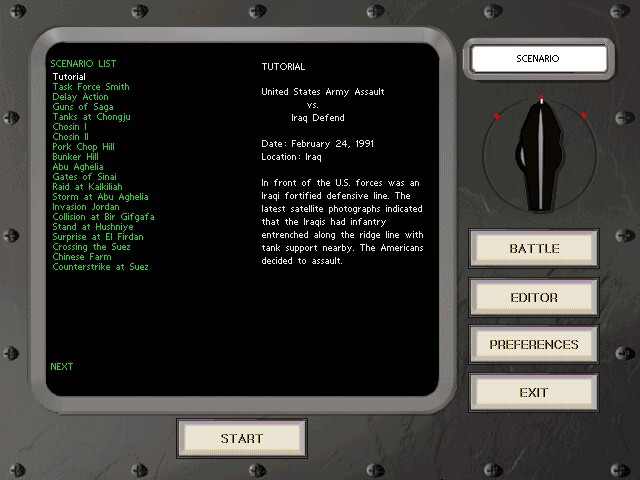
Actual Game
Steel Panthers II: Modern Battles1-Click Install
|
The Game
"It wasn't fair," an Iraqi general is supposed to have said to his American captors during the Gulf War. "We didn't know you were attacking until all our tanks had blown up."
If you're like most people you watched the Allied forces roll up the Iraqi army with something akin to awe. The bloody attrition of World Wars I and II and the stalemates of Korea and Vietnam culminated in the Gulf War's efficient, lethally precise modern warfare, and Steel Panthers II: Modern Battles captures it perfectly. Encompassing the epic sweep of post-World War II combat, from 1950 to 1999, it puts you on the battlefields that have defined this half-century of combat.
Steel Panthers II follows up the successful Steel Panthers, which dealt exclusively with combat in World War II. Created from a core design by wargame vets Gay Grigsby and Keith Brors, with an engine and graphics from SSI's special project team, SP1 had the perfect balance of playability and depth, with a large database, a wide variety of scenarios and campaigns, and the ability to create your own custom maps and scenarios. SP2 offers a similar engine with several new features, but more important is the massive new database of 1,000 modern units. Infantry, armor, artillery, and air assets are all modeled in depth, and units have characteristics unique to each time period used in the game.
Let's take a look at the engine and its refinements first. SP2 is a tactical, turn-based wargame, so it deals with small unit formations such as squads, platoons, and companies. The map is a traditional hex-grid design (you can turn a hex overlay on or off) with terrain features ranging from hills and rivers to bridges and buildings. Move your units across the map and, when an enemy unit is in range, click on the crosshairs to attack. Artillery is primarily "off map" and is controlled through a separate panel where you select the target and type of barrage (smoke, cluster, or high explosive shells). This panel also enables you to order air attacks.
There are several refinements to this system, and all improve gameplay by giving you more control over how you set up an attack. A new "shift barrage" feature allows you to redirect artillery fire within a certain area without waiting a turn. When ordering air attacks (and the use and modeling of air assets is far more extensive than in SP1), you can now set ingress and egress points for each flight. This means you can set up a run by an A-10 along the line of a road to catch as many enemy units in one flight as possible. (Previously, an air unit would just cross the road from any direction and hit a single spot.) Finally, you can call up a unit information screen and set the primary weapon. For example, you can choose to have an engineer use only his flame thrower, or an Apache fire just a rocket salvo rather than a Hellfire missile. All this gives a much larger range of control over battles than SP1 offered, and improves on an already solid game engine.
The new database shows the drastic change in the nature of warfare and the unique qualities of the modern battlefield. Scenarios take on the Korean War, the Arab-Israeli Wars, Vietnam, Afghanistan, the Gulf, and others, with full campaigns for Korea 1950, Golan Heights 1973, Germany 1980 (hypothetical height of the Cold War stuff), Desert Storm 1991, and hypothetical US versus China and US versus Japan.
The missions and campaigns included draw from many of the major conflicts since WWII, and some yet to come. The 51 stand-alone scenarios and six full campaigns will be plenty to keep folks busy while they wait for the first expansion sets and user-made scenarios. An interesting new feature, the random battle and campaign generator, pretty much rolls a new battle on the fly as you set preferences for such things as opposing sides, time period, landscape, and so on. And, as with the first SP, the scenarios editor gives this one an infinite life. You can build maps from scratch, make orders of battle for any of the 40 countries represented, and create custom scenarios of just about anything. It ain't easy, but it's fun.
The weapons brought to bear in these battles highlight the evolution of technology: weapons shoot further and are more lethal, gunship support changes the whole dynamic of the battle, and never screw with an M1A1 Abrams. Little touches will thrill some wargamers. For instance, you can set the height of a chopper from landed, to nap of earth, to high altitude, each with its own uses in different situations. (At high altitude, you even see a little helicopter shadow on the ground.) Watching a tight American armored assault shred an enemy with the one-two punch of Apache and Abrams is about as cool as wargaming gets. Jungle fighting in Vietnam, with Hueys sweeping out of the sky for double envelopments, is a rare experience for computer gamers. Even better are the guided-missile vehicles and teams, which are a real trip to watch. The little map animations are as good as they were in the first SP: buildings cave in, bomb craters form, fields burn.
This is the best modern warfare game of the era, deep enough to satisfy the most dedicated wargamer, and playable enough to please the novice. What more could you want?









